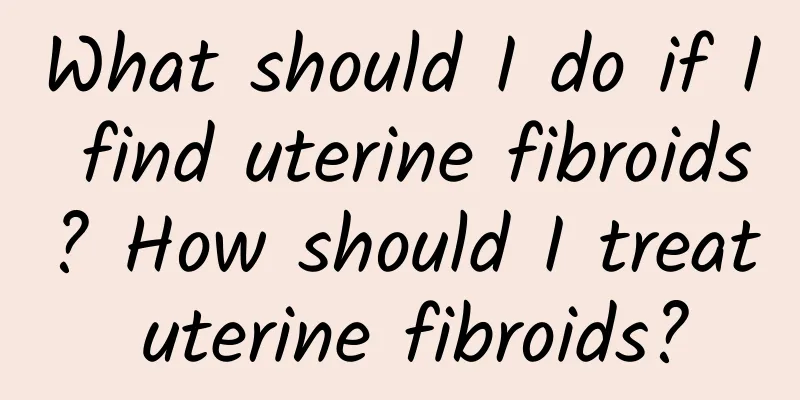What should I do if I find uterine fibroids? How should I treat uterine fibroids?

|
Uterine fibroids are more common in today's society, and many unmarried women also suffer from this disease. Although uterine fibroids are benign tumors, due to the harm to women, women should still pay attention to the prevention and treatment of the disease. So, how to detect uterine fibroids? The following is a detailed introduction. If uterine fibroids are found, they should be treated promptly. If not treated promptly, they may continue to grow and degenerate. Specific treatment methods are as follows: 1. Continued observation: If the fibroids are small and asymptomatic, generally no treatment is required, especially for patients near menopause. Due to low estrogen, the fibroids can shrink or disappear naturally, and follow-up can be done every 3-6 months. If the uterine fibroids increase in size or symptoms are obvious, please consider further treatment. 2. Drug treatment: For patients with fibroids within the size of a 2-month pregnant uterus, mild or mild symptoms, near menopause and general condition that cannot be operated on, symptomatic drug treatment can be used. (1) Androgens: They counteract estrogen, cause endometrial atrophy, and directly act on smooth muscle to cause contraction, reduce bleeding, and cause premature menopause in near-menopausal patients. Commonly used drugs: 5 mg of methyltestosterone, sublingually, twice a day, 20 days a month; or 25 mg of testosterone propionate, injected intramuscularly, once a day, 3 times in total, with a monthly total of no more than 300 mg, to avoid virilization. (2) Anti-estrogen preparations: Tamoxifen can be used to treat significantly increased menstruation and fibroid size such as pregnancy less than 2 months, 10 mg orally twice a day for 3-6 months. After use, menstruation is significantly reduced and fibroids can also be reduced, but they can gradually increase after stopping the drug. Side effects are menopausal syndrome, such as hot flashes, impatience, sweating, vaginal dryness, etc., and there may also be amenorrhea and a small amount of irregular vaginal bleeding. (3) Luteinizing hormone-releasing hormone (LHRH) analogs: LHRH analogs can inhibit pituitary and ovarian function, reduce estrogen levels, and treat small fibroids (≤ 2 months of gestational uterus), increased menstrual volume or shortened cycles, and menopausal or postmenopausal patients. LHRH-A 300 micrograms or 500 micrograms, used continuously for 3-6 months. Side effects of tamoxifen. 3. Surgical treatment: If the fibroids are larger than a 2.5-month pregnancy or the symptoms are obvious, surgical treatment is often required if secondary anemia occurs. Through the above content, we know what to do if you have uterine fibroids. It can be seen that there are many treatment methods and patients do not have to worry too much. However, this disease should be treated early, especially for infertile women. The treatment method should be chosen carefully. In addition, some things need to be paid attention to during the treatment, such as eating a light diet, paying attention to rest, etc. |
>>: What should women do if they have uterine fibroids? Are uterine fibroids benign tumors?
Recommend
Choosing the right treatment for cervical erosion
There are many ways to treat cervical erosion, bu...
Is cervicitis the same as cervical erosion?
Is cervicitis the same as cervical erosion? Many ...
Hospitals that treat congenital absence of vagina
Congenital absence of vagina is caused by the sta...
What are the symptoms of miscarriage?
Pregnancy is a happy thing for women, but various...
Should I eat meat or vegetables to lose weight? First check the metabolic constitution
I often hear people complain: "Others say th...
What are the causes of cervicitis?
Generally speaking, cervicitis is not very scary....
Things You Don't Know About Grapefruit and Internal Environmental Protection
Time flies, and the Mid-Autumn Festival is here a...
Early and late symptoms of bacterial vaginosis
Perhaps many women think that bacterial vaginosis...
How to treat severe cervical erosion? Several methods to treat severe cervical erosion
Cervical erosion is a disease that our female fri...
What causes dysmenorrhea?
I believe that female friends should be familiar ...
The harm of chronic cervicitis: it will increase the patient's chance of cancer!
Chronic cervicitis is very harmful. Female friend...
Recommended Medicinal Diet for Patients with Irregular Menstruation
Irregular menstruation is one of the most common ...
Want to know the correct way to relieve dysmenorrhea?
I believe that all fairies have a say in the pain...
Here are some common symptoms of ovarian cysts
In real life, the symptoms of ovarian cysts are r...
Acute adnexitis should be treated promptly
Acute adnexitis must be treated in a timely manne...









